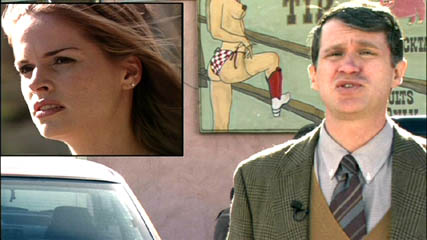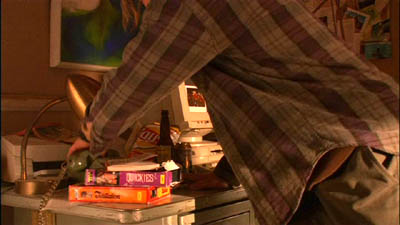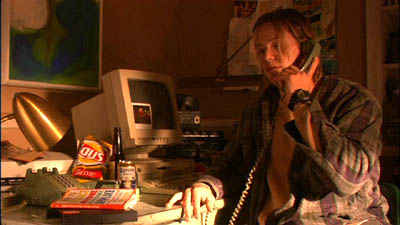|
American Crime is a complicated, multi-layered, multiple murder mystery. When a topless dancer's corpse is found by some fishermen, they hope to earn a reward by calling a local TV station instead of the police. As the plot thickens, the producer (Anabella Sciorra), the ambitious female reporter (Rachel Leigh Cook), and a techie intern (Kip Pardue) realize that maintaining an exclusive on the case presents their lifetime career opportunity, so they continue to keep the police in the dark while they uncover a chain of clues. The dead woman's belongings include a video tape of her, and the footage was apparently filmed without her knowledge by a stalker. That might not be so suspicious except that another women is also shown on the tape and that woman is also dead, murdered some time earlier. The investigators conclude that the stalker's m.o. is to tape "stalker footage" of a prospective victim before killing her, followed by sending the tape to his next prospective victim, along with similar "stalker footage" of herself. |
|
|
The case gets far more complicated when the next tape
seems to identify the female reporter as the next victim. She
simply decides to get the hell out of Dodge and moves several
hundred miles away, leaving the mystery to the others. The resignation of the reporter finally attracts some national and international attention, so the small town is visited by a British reporter from a big syndicated U.K. show called "American Crime". (This part is played by an almost unrecognizable Cary Elwes, as seen in the capture to the right.) The "American Crime" reporter joins the local producer and her intern in the complicated investigation, but he seems to be a complete putz in every way, so hilariously incompetent that one might reasonably doubt whether he is a reporter at all! |
 |
|
As the film progresses, the paranoia of the investigators runs high and each of them realizes that any of the others might actually be the murderer. This situation was managed very effectively so that the writers and director didn't have to provide the customary clumsy "red herrings", but allowed the suspicion to shift back and forth naturally, as each of the primary characters interpreted signs and clues rationally, yet with their reason shrouded sufficiently by the veil of their own paranoia so that everything seemed to be a clue and anyone could have been seen as a potential murderer. You won't have to worry about my spoiling the mystery for you, because I still don't know for sure who the killer is. The film has an ending which shows one person confessing to the crime on tape, then arguing that the confession was extracted under duress. The epilogue does seem to confirm that the confessed murderer could not have committed the crimes. This movie was shot entirely on digital video in a widescreen aspect ratio, and was edited with the slick professionalism of a top notch ad or a TV show intro, as befitting the fact that it is at times a TV show within a film, and even a TV show within a TV show within a film. (The "American Crime" show is shown covering the local investigation as a news story it itself, and the local broadcasts are also shown at times.) Some of the direction is gimmicky, bordering on surreal and symbolic, sometimes even crossing those borders. Furthermore, some of the footage is deliberately obfuscated by the director's technique, since it involves, in the most radical case, a guy filming a TV which is playing a tape of a women watching another tape of herself on her own TV. If you were to argue that the whole project sounds a bit "over directed", you might have a fair point, but I would respectfully disagree. I would normally be uncomfortable with how the macabre humor and the surrealism destroy the "fourth wall" in a serious murder investigation, and I would normally carp about all the layers of films within films until the entire project seems like a nested Russian puzzle, but in this case I think the entire presentation worked very effectively. It is slick, engaging, creepy, and mysterious. I really enjoyed the nebulous ending as an alternative to the usual spoon-fed and contrived answer. In fact, I was so involved in the puzzle that I watched most of the film a second time to see if I could be certain of the identity of the killer or killers. I think I know, but I'm not certain, and that ambiguity really provided a sense of involvement that I used to get from the best works from Hitchcock and Serling. Although American Crime went straight to video, it was a helluva lot more interesting and proficient piece of genre filmmaking than most of the theatrical releases I saw in the past year. This is the most original reworking of the overdone serial murderer formula in a long time, and the director, Dan Mintz, showed a real knack for combining macabre imagination with glitzy techno skills to package the creepy thrills. My hat is also off to the proficient editor, Todd Miller, and to the creator of the opening credits, if that was someone other than the director or editor. Those credits are a delightful blend of technology and artistry. I almost didn't look at this film because I've been busy and it was one of this week's minor releases, but I'm glad I did. I radically underestimated it. It grabbed my attention right from the "git-go", and never let up. I ended up enjoying it! * If you have seen the movie and would like to read my speculation on the identity of the murderer, see the section below in yellow. |
|
|
|
|
|
Oops! A slap on the wrist for the continuity person! Kip finds that answering the phone will make video tapes disappear. |
|


